Midlothian
Bottom Line: If You Think DFW Still Has A Smog Problem, Be in Arlington Tonight
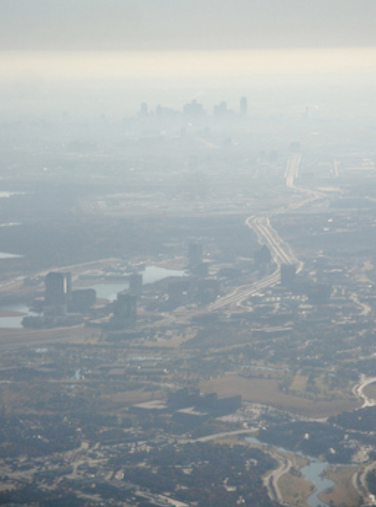 You don't have to have any special technical knowledge. You don't have to know regulatory or legal jargon. You just have to believe we still have a problem with smog in Dallas-Fort Worth. That's all it takes to participate in the air quality extravaganza happening tonight in Arlington. It's a rare two-for one chance to help the fight for cleaner air.
You don't have to have any special technical knowledge. You don't have to know regulatory or legal jargon. You just have to believe we still have a problem with smog in Dallas-Fort Worth. That's all it takes to participate in the air quality extravaganza happening tonight in Arlington. It's a rare two-for one chance to help the fight for cleaner air.
Public Hearing on the State's New DFW Air Plan 6:30 pm Tonight, Arlington City Hall, 101. W Abram
All you have to do is sign-up to speak, wait for your name to be called, and tell the state and the EPA representatives who'll be present that you want something better than a clean air plan that does nothing to get cleaner air except wait for a new federal gasoline formula to hit the market a year before the plan's deadline. The more people that do this, the more pressure EPA is under to reject this terrible state plan. Nothing fancy. Just show up and say you want better – that this region deserves better after two decades of being in violation of the Clean Air Act.
Click here to send prepared written comments to the state and EPA. You can add your own as well.
Roasting and Toasting of Retiring State Representative Lon Burnam – A Fundraiser for Downwinders at Risk, 7:30 -10 pm, Tonight, South Street Patio, 400 South Street – about four blocks east of Arlington City Hall
If you think DFW smog is still a problem, after you say your piece at the state hearing come and support the only group committed to trying making its elimination a priority – Downwinders at Risk. Since the mid-1990's we've been using these air plans to raise issues, get information, and sometimes even win victories that actually do lead to cleaner air. A big reason there's no more burning of hazardous waste in the Midlothian cement plants, and all of those cement plants have upgraded their equipment is because of the work we did around smog. Lately, we've been using them to drive home how much gas and oil pollution contribute to regional smog.
But we need your help – in terms of attendance at public hearings, and in terms of financial assistance. For your donation of $35 to this roasting and toasting of Lon, you get an evening of entertainment and take part in a salute to a real local clean air hero. And you make it more possible to keep challenging the status quo on behalf of your lungs.
CLICK HERE TO GET YOUR TICKETS ONLINE OR GET THEM AT THE DOOR TONIGHT
If you still think we have a smog problem, there's two things you can do about it tonight. Thanks.
Citizens To Form Posse, Demand State Enforce the Clean Air Act at Thursday Hearing on New DFW Air Plan
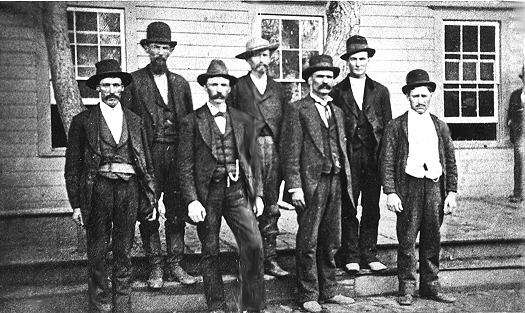 (Arlington) Critics of a new plan to clean the air in Dallas-Ft. Worth are using a public hearing on Thursday evening to accuse the state of Texas of breaking the law by not requiring the implementation of pollution control technologies already in widespread use to help lower smog levels in North Texas.
(Arlington) Critics of a new plan to clean the air in Dallas-Ft. Worth are using a public hearing on Thursday evening to accuse the state of Texas of breaking the law by not requiring the implementation of pollution control technologies already in widespread use to help lower smog levels in North Texas.
“We’re asking residents to come out and get sworn into a citizens posse to help us make the state follow the Clean Air Act,” said Jim Schermbeck, Director of the local clean air group Downwinders at risk, one of the leading opponents of he new plan. “Austin is going to ridiculous, Monty Python-like lengths to avoid new controls on the Midlothian cement plants, East Texas coal plants, and local gas facilities in this new plan – even though those controls are now commonplace in each industry.”
Thursday’s public hearing centers on a new plan to comply with the federal ozone standard of 75 parts per billion (ppb) by 2018. DFW has never achieved such a low level of smog, and only this last year dipped below the 1997 standard of 85 ppb for the first time with the help of cooler, wetter summer.
EPA says a state plan like the one the Texas Commission on Environmental Quality is proposing for DFW must include “all Reasonable Available Control Technologies,” and “all Reasonable Available Control Measures” to get lower smog levels as “expeditiously as possible.” EPA defines these as technologies as ones that are “technically and economically feasible.” But according to Schermbeck, the state of Texas is deliberately ruling out local use of pollution controls already adopted by industry that could speed cleaner air.
He cited three examples. Selective Catalytic Reduction, or SCR acts much like the catalyst on cars, only on a much larger scale for industrial plants. It’s already in use on at least half a dozen European cement plants where it’s reduced smog-forming pollution by up to 90%, and on many coal-fired power plants across the world and in the US, where it achieves the same results. Yet the TCEQ DFW air plan doesn’t require SCR on the largest single sources of smog pollution in the region, the Midlothian cement plants, or the East Texas coal plants that are known to impact DFW air quality, saying the technology isn’t “feasible.” TCEQ maintains this stance even though the Holcim cement plant in Midlothian has announced plans to include an SCR unit on one of its own kilns.
“Here’s a pollution control technology already in operation and achieving great results, with a cement plant in North Texas already adopting it, but the state’s position is that it isn’t ‘feasible’. It’d be comical if it wasn’t delaying cleaner air for over 6 million people that haven’t had it in decades.”
Besides ignoring SCR on cement and coal plants, Schermbeck said the TCEQ has also ruled-out electrification of large gas compressors as “infeasible” – despite the widespread use of electric compressors In the Barnett Shale already and the requirement of municipalities like Dallas and Southlake to allow nothing but electric compressors within their city limits. According to a 2012 study by the Houston Advance Research Consortium, compressors could increase downwind ozone levels as much as 3 to 10 parts per billion. There are at least 647 large compressors in the DFW “non-attainment area” covered by the TCEQ air plan.
“Requiring just these three technologies that are already on the market and being used in their respective industries could reduce air pollution by thousands of tons a year and help us achieve compliance with the new federal ozone standard much quicker,“ said Schermbeck. He said they all pass the test of being feasible according to EPA definitions. “By law, they should be required.”
Instead, the state is relying exclusively on a new federal gasoline mix being introduced in 2017 to achieve the required 75 ppb standard by 2018. Although it’s expected to help lower ozone levels across the country, it won’t get DFW down to the level of 75 ppb alone. To make the plan work on paper, the state has had to estimate oil and gas pollution downward in a way Schermbeck and others claim is unrealistic.
“Basically, the state’s approach is to do absolutely nothing for the next three years and hope the federal gasoline change brings it “close enough” to the lower standard. But hope is not a plan.”
Schermbeck said his group would be passing out badges to members of their clean air posse and recruiting residents to persuade the EPA to reject the state’s proposal. The federal agency has the final say. But there’s also always court – where many clean air rules for the state of Texas have been decided over the last 20 years. “If government won’t enforce the law, we may have to do it ourselves.”
TCEQ’s Terrible, Horrible, No Good, Very Bad Air Plan for DFW
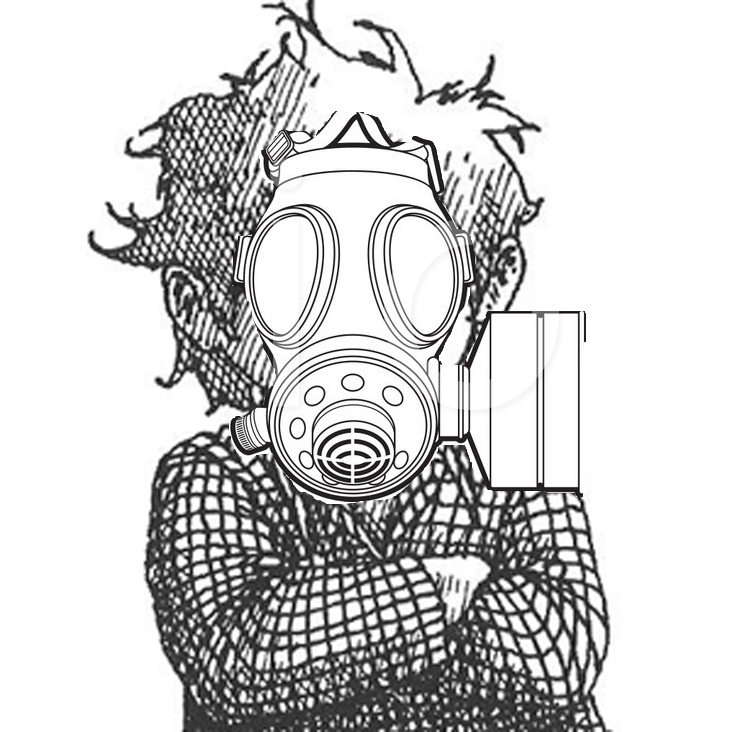
TCEQ Public Hearing on the new DFW Anti-Smog Plan
Thursday, January 15th 6:30 pm
Arlington City Hall, 101 W. Abram
Over the last two decades, we've seen some pretty lame DFW clean air plans produced by the state, but the newest one, scheduled for a public hearing a week from now, may be the most pathetic of the bunch.
From a philosophical perspective, the Texas Commission on Environmental Quality stopped pretending to care about smog in DFW once Rick Perry decided to run for president around 2010 or so. Computer modeling was scaled back, staff was slashed, and the employees that were left had to be ideologically aligned with Perry's demand that no new controls on industry (i.e potential or existing campaign contributors) was preferable to six or seven million people continuing to breathe unsafe and illegal air.
TCEQ's 2011 anti-smog plan reflected that administrative nonchalance by concluding – in the the middle of the Great Recession – that consumers buying new cars would single-handedly deliver the lowest smog levels in decades. It did not. It went down in history as the first clean air plan for the area to ever result in higher ozone levels. The first, but maybe not the last.
This time around, it's not the cars themselves playing the role of atmospheric savior for TCEQ, but the fuel they'll run on. Beginning in 2017, the federal government is scheduled to introduce a new, low-sulfur gasoline that is predicted to bring down smog by quite a bit in most urban areas. Quite a bit, but not enough to reach the ozone standard of 75 ppb that's necessary to comply with the Clean Air Act by 2018. It's the gap between this official prediction and the standard where the state is doing a lot of hemming and hawing.
TCEQ staffers really did tell a summertime audience in Arlington that that estimated 2018 gap of between 1 and 2 ppb was "close enough" to count as a success. Now, you might give them the benefit of the doubt, but remember this is an agency that has never, ever been correct is its estimation of future ozone levels. After five attempts over the last two decades, TCEQ has never reached an ozone standard in DFW by the official deadline. Precedent says this plan won't even get "close enough."
Plus, we know getting "close" to 75 ppb isn't protecting public health in DFW. Even as this clean air plan is being proposed by Austin, the EPA is moving to lower the national ozone standard to somewhere between 60 and 70 ppb (There's a hearing on that at Arlington City Hall on January 29th). That new EPA ozone standard is due to be adopted by the end of this year. So this entire state plan is obsolete from a medical perspective. Instead of aiming for a level of ozone pollution closer to 70 ppb as soon as possible, it's not even getting down to a flat 75 ppb at all DFW monitors by 2018. It wil take an entirely new plan, and pulling TCEQ teeth, to do that much later. In other words, millions of people will have to wait as much as a five to seven years longer to get levels of air quality we know we need now in 2015.
What are the major flaws this time?
1. TCEQ is Using 2006 in 2014 to Predict 2018.
The EPA recommends that states use an "episode" of bad air days from the last three years – 2009-2013 – in trying to estimate what ozone levels will be three years from now. The more recent the data, the better the prediction.
TCEQ is ignoring that recommendation, relying on a computer model that's already nine years old. This has all kinds of ramifications on the final prediction of compliance. Instead of having more recent weather data, you have to "update" that variable. TCEQ doesn't have to compensate for the drought DFW is experiencing now or factor in a year like 2011 where the drought caused a worst case scenario for ozone formation.
TCEQ isn't using more recent data on how sensitive monitors are to Nitrogen Oxide (NOx) and Volatile Organic Compounds (VOCs) – the major kinds of pollution that cause smog . That's important because gas production in the Barnett Shale has put a lot more VOCs in the air. But instead of getting a more accurate post-drilling boom read on what's driving smog creation, the TCEQ is relying on a picture that starts out before the boom ever started.
The further you reach back in time for a model to predict future levels of smog, the fuzzier that future gets, and the less accurate the results. TCEQ is using a model that's twice to three times older than EPA guidance recommends. What are the odds that TCEQ estimates will be correct based on this kind of methodology?
2. TCEQ is Downplaying OIl and Gas Pollution
Citizens attending the air quality meetings in Arlington over the past year have seen the TCEQ try and hide the true volume and impact of oil and gas pollution at every turn. Instead of all the industry emissions being listed under the single banner of "Oil and Gas Pollution," the Commission has tried to disperse and cloak them under a variety of categories in every public presentation.
"Other Point Sources," a classification that had never been seen before, was the place where pollution from the 647 large compressor stations in DFW could be found – if you bothered to ask. "Area Sources" was where the emissions from the thousands of other, smaller compressors could be found – again, only if you asked. "Drilling" was separate from "Production." And despite other agencies being able to tease out what kind of pollution came from the truck traffic associated with fracking within their jurisdictions, the TCEQ never bothered to estimate how much of the emissions under "Mobile Sources" was generated by the Oil and Gas industry.
The reason the TCEQ has tried so hard to hide the true volumes of oil and gas pollution is because once you add up all of these disparate sources, the industry becomes the second largest single category of smog-forming pollution in DFW, second only to on-road cars and trucks (and remember many of those trucks are fracking-related). According to TCEQ's own estimates, oil and gas facilities in North Texas produce more smog-forming VOC pollution than all of the cars and trucks in the area combined, and more smog-forming NOx pollution than the Midlothian cement plants and all the area's power plants combined.
TCEQ is loathe to admit the true size of these emissions and place them side-by-side next to other, traditional sources, lest the public understand just how huge a impact the oil and gas industry has on air quality. Austin's party line is that this pollution isn't contributing to DFW smog – that it's had no impact on local air quality. But such a claim isn't plausible. If cars are a source of smog, and cement kilns and power plants are a source of smog, how can a category of VOC and NOx pollution dwarfing those sources not also be a source of smog? Think how much less air pollution we'd have if the Barnett Shale boom of the last eight years had not taken place?
In it's last public presentation in August, the TCEQ made the impact of oil and gas pollution clear despite itself. According to the staff, oil and gas emissions were going to be decreasing in the future more than they had previously estimated. As a result, a new chart showed that certain ozone monitors, including the one in Denton, would see their levels of smog come down significantly. It was exactly the proof of a causal link between gas and smog that TCEQ had been arguing wasn't there. Only it was.
In terms of forecasting future smog pollution, TCEQ is underplaying the growth of emissions in the gas patch. Everything it's basing its 2018 predictions on is years out-of-date, leftover from its last plan.
Drilling rig pollution is extrapolated from a 2011 report that counts feet drilled instead of the actual number of rigs. TCEQ predicts a decline in drilling and production in the Barnett Shale without actually estimating what that means in terms of the number of wells or their location. It also assumes a huge drop-off in gas pollution after 2009 that hasn't been documented by any updated information. It's only on paper.
While recent declines in the price of oil and gas have certainly put a damper on a lot of drilling activity, there's still a significant amount going on. Look no further than Mansfield, where Edge is now applying for permit to build a new compressor and dozens of new wells on an old pad.
In 2011, nobody was building Liquified Natural Gas terminals up and down the Gulf Coast for an export market the way they are now. Analysts say those overseas markets could produce a "second boom" in drilling activity between now and 2018, but the TCEQ forecasts don't take that into account.
Gas production pollution numbers – emissions from compressors, dehydrators, storage tanks – are even more tenuous. Every gas industry textbook explains that as gas plays get older, the number of lift compressors increases in order to squeeze out more product. Increase the number of compressors and you increase the amount of compressor pollution. But TCEQ numbers fly in the face of that textbook wisdom and predict a decline in compressor pollution because wells in the Barnett Shale are getting older!
The best analogy for how TCEQ is estimating oil and gas pollution is its poor understanding of where those thousands of smaller compressor are and how much pollution they're actually producing. No staff member at TCEQ can tell you how many of those compressors there are in the region – they literally have no idea and no idea of how to count them in the real world. There are just too many, their locations are unknown, and they were never individually permitted.
Instead, the TCEQ takes production figures from the Railroad Commission and guesses how many of those small compressors there are, as well as their location, based on where the RRC tells it production is going on in the Shale. Then staff guesses again about the emissions being emitted by those compressors, because there's no data telling them what those emissions actually are. In the end you have a series of lowballed guestimates, stacked one atop the other, presented as fact. It's smoke and mirrors.
3. TCEQ Isn't Requiring Any New Controls on Any Major Sources of Air Pollution
Like its previous 2011 DFW air plan, which resulted in an increase in North Texas ozone levels, TCEQ's new plan requires no new controls on any major sources of air pollution, despite evidence showing that such controls in smog-forming emissions from the Midlothian cement plants, East Texas coal plants, and Barnett Shale gas facilities could cut ozone levels significantly.
Selective Catalytic Reduction (SCR) is already used extensively in the cement plant industry in Europe to reduce smog pollution by up to 90%. Over a half dozen different plants have used the technology since 2000. The TCEQ's own 2006 report on SCR concluded it was "commercially available." Holcim Cement has already announced it will install SCR in its Midlothian cement plant. Yet the TCEQ makes no mention of this in its plan.
That's right, a cement plant in Midlothian has decided SCR is commercially viable, but the State is looking the other way and pretending this development in its own backyard isn't even happening. TCEQ is stating in its proposed plan that SCR just isn't feasible!
In 2013, a UTA Department of Engineering study looked at what happened if you reduced Midlothian cement plant pollution by 90% between 6 am and 12 Noon on weekdays. Ozone levels went down in Denton by 2 parts per billion. That may not seem like a lot, but in smog terms it's the difference between the Denton air monitor violating the 75 ppb standard under the TCEQ plan and complying with the Clean Air Act.
In 2012 a UTA College of Nursing study found higher rates of childhood asthma in Tarrant County "in a linear configuration" with the plumes of pollution coming from the Midlothian cement plants. SCR means less pollution of all kinds: smog, dioxins and the particulate matter the Nursing College thought was causing those increased rates of childhood asthma. By delaying the requirement that all the Midlothian cement plants install SCR by 2018, the state is turning its back on a problem that Cook Children's hospital described as "an epidemic."
The same is true of SCR in the East Texas coal plants. The technology is being used in other coal plants around the world and in the US to reduce smog pollution. There's no reason it shouldn’t be required for the dirtiest coal plants in Texas that impact DFW air quality. After decades of being out of compliance with the Clean Air Act, DFW is one of the places the technology is needed most.
Last year the Dallas County Medical Society, led by Dr. Robert Haley, petitioned the TCEQ to either close those coal plants or install SCR on them. The doctors' petition was rejected by TCEQ Commissioners and they were told their concerns would be addressed in the DFW air plan. They aren't. Those concerns, along with the proof they presented about the impact of the plants on local air quality, are being ignored.
Electrification of gas compressors is a commonly used technology that could cut smog pollution as well, and yet the TCEQ is not requiring new performance standards that would force operators of hundreds of diesel and gas-powered compressors in North Texas to switch to electricity.
A 2012 Houston Advanced Research Center study found that pollution from a single compressor could raise local ozone levels by as much as 3 to 10 ppb as far away as ten miles. There are at least 647 large compressor stations in the western part of the DFW area. Dallas and other North Texas cities have written ordinances requiring only electric-powered compressors within their city limits based on testimony from industry that electrification was a commonly used technology in the industry. And yet, TCEQ's official position is that electrification isn't feasible.
In ignoring these types of new controls the TCEQ is violating provisions of the Clean Air Act to implement "all reasonably available control technologies and measures" to insure a speedy decrease in ozone levels. Each of these technologies is on the market, being used in their respective industries, and readily available. Studies have shown that each of these technologies could cut ozone levels in DFW significantly, but the TCEQ is refusing to implement them. In doing so, many observers believe it's blatantly in violation of the law.
We don't expect TCEQ to change its position. That well has been poisoned for the foreseeable future. But we do expect a higher standard of enforcement from the Obama Administration EPA. That's why we're asking you to show-up at the public hearing and oppose this dreadful state air plan a week from now in Arlington. We need to demonstrate to the federal government that citizens are concerned about getting cleaner air now, not in the next plan or the one after that. Now. We need to put pressure on the EPA to reject this TCEQ plan, to either send it back to the drawing board or substitute one of its own. Without you showing up, that pressure isn't there.
Between now and Thursday – and all the way through January 30th, you can send prepared comments opposing the TCEQ plan to Austin and the EPA Regional Administrator with a simple click here – and add your own comments as well.
As a reward for coming over and venting your frustration, we'd like you to stay and party with us at the official "retirement party" of State Representative Lon Burnam, beginning at 7:30 pm just four blocks down the street. It's a roasting and toasting of the best friend environmentalists ever had in the Texas Legislature, as well as a fundraiser for Downwinders to continue our work to defend your air. JUST CLICK HERE FOR TICKETS.
Next Thursday you can support clean air two ways in one evening. Help us beat back a terrible, horrible, no good, very bad air plan, and then come celebrate the wonderful, righteous, very good work of a dedicated public servant. See you there.
2014 DFW Smog Report: Good News But Don’t Hang Up the Gas Mask Yet
 For the first time since DFW began recording its smog levels, the region's three-year running average dipped below the 1997 eight-hour 85 parts per billion (ppb) standard. After years of leveling off at around 86-87, it's dropped to 81 ppb. That's good news.
For the first time since DFW began recording its smog levels, the region's three-year running average dipped below the 1997 eight-hour 85 parts per billion (ppb) standard. After years of leveling off at around 86-87, it's dropped to 81 ppb. That's good news.
DFW's decrease is attributed to 2011's terrible numbers rolling off the board and a wetter, cooler and windier summer than normal these last five months or so. As both drought-ridden 2011 and this year's results demonstrate, weather still plays an extremely critical role in how large or small our smog problem will be. Another summer or two like 2011 could easily put us back over the 1997 standard. More wet and cooler weather could see the decrease continue.
The news would be better except that we were supposed to have originally accomplished this milestone in 2009, then again last year after a second try, according to the Texas Commission on Environmental Quality (TCEQ).
As it is, we still haven't reached the current, more protective 2008 national standard that was revised downward to 75 ppb after a review of the scientific literature.
In January, TCEQ will host a public hearing on its proposed "plan" to EPA to meet that goal that predicts most, but not all DFW monitors will reach 75 ppb by the summer of 2018.
Despite overwhelming evidence that new controls on the Midlothian cement plants and the reduction of gas industry pollution could speed this achievement, TCEQ's new plan contains no new pollution control measures on any major sources of smog polluters – cement kilns, coal plants, gas sources – but instead relies on the federal adoption of a new lower-sulfur gasoline mix for on-road vehicles. Like past proposals by Rick Perry's TCEQ, this one depends solely on the feds to get them into compliance. TCEQ isn't lifting a regulatory finger to help.
And its new plan once again aims high, not low. At last count, there were at least three Tarrant and Denton County monitors that TCEQ admitted would still be above the 75 ppb standard at the end of 2018. "Close enough" is the reply from Austin.
From a public health perspective, it's even worse. Why does the ozone standard keep routinely going down? Because new and better evidence keeps accumulating to show widespread health problems at levels of exposure to smog that were once considered "safe." About every five years, the EPA's scientific advisory committee must assess the evidence and decide if a new standard needs to be enforced to protect public health.
For most of the last ten years, the position of this independent panel of scientists is that the standard should be somewhere between 60 and 70 ppb. They were ignored in 2008. They were ignored in 2011. They once again came to this conclusion last May. What was the evidence that persuaded them? That the current 75 ppb standard for smog causes almost 20% of children in "non-attainment areas" to have asthma attacks, and leads to hundreds of thousands of deaths every year. Cutting the standard to 60 ppb reduces those deaths by 95%. Since the Clean Air Act states the EPA is duty bound to set a smog standard protective of human health, 60 ppb seems to be the threshold level that the current scientific literature says is actually safe for the majority of the population most vulnerable to the impact of bad air. By contrast, a smog level of 70 ppb only reduces those deaths by 50%. (Policy Assessment for the Review of the Ozone National Ambient Air Quality Standard, U.S. Environmental Protection Agency, Office of Air and Radiation, Office of Air Quality Planning and Standards, Health and Environmental Impacts Division, Ambient Standards Group, August 2014)
By December 1st, EPA Administrator Gina McCarthy must decide whether to officially recommend a standard in that 60-70 ppb range. It looks as though this time, the EPA might just endorse what the scientists are recommending, although it's unclear whether it'll be the upper or lower part of that range.
So even while the TCEQ is saying it's "close enough" to achieving the 75 ppb standard left over from George W's administration by 2018, the evidence is that level is too high to prevent large public health harms and must be lowered. A lot.
This is why it's so infuriating that the TCEQ is satisfied with getting only "close enough" to a 2008 standard that's about to become obsolete. Austin knows it could demand better air pollution control measures on the market right now that would accelerate the decrease in smog. It knows the pubic health would benefit from requiring such measures. But it's willing to condemn DFW children and others at risk for many more years for the sake of keeping its "business-friendly" reputation.
And while this year's slip below the 85 ppb standard is a sign of some progress, it remains true that DFW still has the worst air in Texas – a title we took from Houston years ago. Take a look at the chart summarizing the 2014 ozone season across Texas. Despite the nicer weather, DFW still had almost twice as many readings above 75 ppb as Houston and four above the 85 ppb standard. Houston had no readings above 85. In fact, San Antonio was the only other city to record a level so high – once.
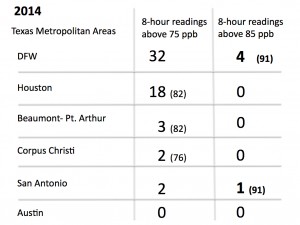 DFW still has a smog problem and all it takes is another hot and dry summer to see it escalate. We need the help more controls on major sources could give us. We need Selective Catalytic Reduction on ALL the Midlothian cement and East Texas coal plants. We need electrification of gas compressors in the Barnett Shale. This should be the message to both the TCEQ and EPA during the public hearing in January.
DFW still has a smog problem and all it takes is another hot and dry summer to see it escalate. We need the help more controls on major sources could give us. We need Selective Catalytic Reduction on ALL the Midlothian cement and East Texas coal plants. We need electrification of gas compressors in the Barnett Shale. This should be the message to both the TCEQ and EPA during the public hearing in January.
DFW smog in 2014: we've met the Clinton era standard for now, on the way to trying to get "close enough" to the W Standard, and still very far from a new Obama standard. Don't hang up the gas mask yet.
After a 14-year Campaign, State-of-the-Art Pollution Control Finally Coming to Midlothian
 (Midlothian) After a 14-year effort by local citizens, Holcim US Inc. is applying for a permit to the Texas Commission on Environmental Quality to install a Selective Catalytic Reduction (SCR) unit in their Midlothian facility. It's the first application for commercial use of SCR technology in any U.S. cement kiln.
(Midlothian) After a 14-year effort by local citizens, Holcim US Inc. is applying for a permit to the Texas Commission on Environmental Quality to install a Selective Catalytic Reduction (SCR) unit in their Midlothian facility. It's the first application for commercial use of SCR technology in any U.S. cement kiln.
DFW-based clean air group Downwinders at Risk has been advocating the use of SCR in the three Midlothian cement plants located just south of I-20 since 2000, when a German cement kiln first operated the technology successfully.
Together, the TXI, Ash Grove, and Holcim plants represent the largest concentration of cement manufacturing in the country and are a major contributor to DFW's historic smog problem.
"We need this pollution control technology in North Texas, and we're pleased to see Holcim's application," said Downwinders Director Jim Schermbeck. "But we wish residents could enjoy its results sooner than Holcim intends."
The SCR unit is planned for Holcim's idle Kiln #2 while a more common Regenerative Thermal Oxidizer will be built for its operating Kiln #1. Both technologies are being installed to meet new EPA emission standards for hydrocarbon pollution from cement plants. Those standards themselves were championed by Downwinders and other citizen groups in 2009, with over 200 people showing up at an EPA hearing the the DFW Airport Hotel to support them.
The deadline for compliance with the new standards is September 2016. However, restarting of Kiln #2, and the introduction of SCR in Midlothian, is dependent on local demand for Holcim's cement, which is still recovering from weak demand during the recession. That lack of demand could delay the technology's inauguration until after 2016.
Nevertheless, according to Schermbeck, Holcim's application for a permit to install SCR makes it's more likely that all of the Midlothian cement plants, and others in EPA "non-attainment areas" for smog pollution around the country, will be adopting it sooner rather than later.
"Holcim's application sets a precedent that's hard to ignore by regulators in Austin and Washington. For the first time a US cement plant has expressed enough confidence in SCR to make it a technically and economically-viable choice for pollution control. There's no going back."
SCR is widely considered to be the most advanced form of pollution control for cement manufacturing, capable of reducing smog-forming pollution by 90% or more, along with significant reductions in Particulate Matter, metals, and Dioxins.
Although about half a dozen European cement kilns are successfully operating the technology, U.S. plants have refused to endorse it. Two EPA-sponsored pilot tests of SCR are being conducted at Indiana and Illinois cement kilns as part of court-ordered settlements. Holcim's application for its Midlothian kiln is the first time and American cement plant is voluntarily approving SCR use.
Although it's not coming in time to impact the current DFW clean air plan, due to go to public hearing in January of next year, Holcim's application will put SCR on the agenda for the next such plan.
Just two weeks ago, EPA staff recommended a new ozone, or smog, standard of between 60 and 70 parts per billion over an eight hour period versus the current limit of 75 ppb. Adoption of a stricter standard is expected to occur by late next year, meaning a plan to meet that standard will be gearing up sometime in the next three to five years. By that time, Holcim's SCR unit should have a track record that can be cited as a reason for all the Midlothian cement plants to use it.
Schermbeck noted that just last month representatives of the TCEQ told a regional air quality meeting in Arlington that SCR was neither an economical nor technically feasible pollution control option for the Midlothian cement plants. He said Holcim's application belies that claim.
A public meeting on the Holcim permit application is being scheduled for early November.
Arrival of SCR on the scene marks the latest and the most dramatic milestone in the transformation of the local cement industry since Downwinders at Risk was founded 20 years ago to stop the burning of hazardous wastes in the Midlothian kilns.
After a 14-year battle, TXI halted its hazardous waste-burning operations in 2008. Downwinders then pursued a six-year "green cement" campaign to replace all seven obsolete and dirtier wet kilns with newer "dry kiln" technology. That campaign ended in 2012 with the announcement that Ash Grove would shutter its three wet kilns and build a new dry kiln in their place. That plant is due to go on line this year.
Adoption of SCR remained a goal of the group through four different DFW clean air plans going all the way back to 2000. Schermbeck said his group made incremental progress each time, winning small and large battles that directly lead to today's news.
"Holcim's application for SCR is the latest testament to the persistence and focus of a small group of committed citizens who have pulled and pushed the U.S. cement industry into the 21st Century one step at a time."
Power of the Press: Week after Trib Report on DFW Smog, First “Exceedences” of 1997 Standard
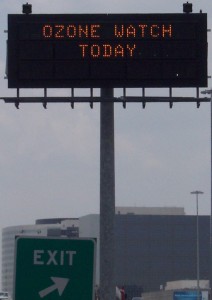 It was only eight days ago the that online Texas Tribune did the first real overview of DFW air quality for this "ozone season." Borrowing heavily from the June 16th Downwinders at Risk presentation to the North Texas regional air quality committee, it concluded that there had been no discernible progress in regional air quality for the past five to six years despite a new state anti-smog plan aimed at getting the area below the 1997 standard of 85 parts per billion.
It was only eight days ago the that online Texas Tribune did the first real overview of DFW air quality for this "ozone season." Borrowing heavily from the June 16th Downwinders at Risk presentation to the North Texas regional air quality committee, it concluded that there had been no discernible progress in regional air quality for the past five to six years despite a new state anti-smog plan aimed at getting the area below the 1997 standard of 85 parts per billion.
Ironically, up to that point, DFW had been enjoying one of the wettest, coolest, most ozone alert-free summers on record. Not one 100 degree day until July and only one "bad air" days of note on June 11th. It looked like we might actually be able to meet the 1997 standard of 85 ppb for the very first time.
That's all changed with this past weeks' return to familiar form. In just seven days, they've been at least four official "ozone alerts" issued for DFW by the Texas Commission on Environmental Quality. Those had produced four "exceedences" of the current 75 parts ppb standard, which the state is now aiming at with another "do nothing" plan under development and due out by the end of the year. On Wednesday the trend got more serious with the addition of the first two "exceedences" of the older 1997 standard we can't seem to conquer – a reading of 88 ppb at the NW Fort Worth monitor at Meacham Field and a 91 at the usually quiet Granbury monitor in Hood County. In the latter case, one mid-afternoon hourly reading reached as high as 113 – just 12ppb short of a violation of an even more ancient standard left over from the 1980's.
For comparison's sake, EPA scientists just sent a letter to EPA Administrator Gina McCarthy recommending that a new, lower federal standard for ozone be set at 60-70 ppb.
It will still take another week of 85 ppb plus days to produce the "fourth highest" readings at the Denton or Keller sites to combine with their 2013 averages and keep DFW in violation of a 17-year old ozone standard. But then again, we have all of August and September to go.
Not surprisingly, two of this summer's hot spots include traditionally troublesome monitors – the Denton and NW Fort Worth site. Tarrant and Denton Counties have historically been the places where the region's highest readings have originated. One reason is wind direction – smog accumulates from upwind sources like the Midlothian cement plants and blows Northwest during the summer. Another more recent reason is the mining of Barnett Shale gas deposits that release huge quantities of smog-forming pollution in the western half of the Metromess, a phenomenon that's been examined in a new UNT study that divided the region's ozone monitors into "Fracking" and "Non-Fracking" areas and found significantly higher readings among those in the Fracking area.
As we went to press with this post, Thursday's readings looked to be producing another round of 75 ppb or higher results. Adding to this year's ozone season irony is that over the last 20 years, July has traditionally been the summer month that produced the fewest number of high ozone readings, book-ended by higher numbers in June and August-September.
Depending on the weather, DFW may still be able to make it over the 1997 standard, 85 ppb hump. But based on this past week's results, that hump just got bigger. Stay tuned.
Ask the State and Holcim To Finally Give DFW “the Holy Grail” of Cement Pollution Control Technology
 Swiss-based Holcim Cement is requesting a permit amendment to add new piece of pollution control equipment to its Midlothian cement plant, one of three cement plants that make the city the "Cement Capitol of Texas" and the largest concentration of cement manufacturing in the U.S. Good news, right? The problem is that the company is asking the state for the permit before deciding what kind of pollution control equipment to install.
Swiss-based Holcim Cement is requesting a permit amendment to add new piece of pollution control equipment to its Midlothian cement plant, one of three cement plants that make the city the "Cement Capitol of Texas" and the largest concentration of cement manufacturing in the U.S. Good news, right? The problem is that the company is asking the state for the permit before deciding what kind of pollution control equipment to install.
That's right. Holcim is asking the Texas Commission on Environmental Quality (TCEQ) to OK a permit that will result in a "major modification" of its Midlothian plant and could produce significant amounts of new pollution before it even decides what the major modification is going to be. Anywhere else in the country this might be a bit odd, but hey, it's Texas, where Rick Perry's TCEQ has a rubber stamp standing by for anything industry requests.
Holcim's permit request is being prompted by a problem complying with new federal regulations limiting a kind of pollution called Total Hydrocarbons, or THCs. These are also sometimes referred to as "Volatile Organic Compounds." Think Benzene, and other kinds of hazardous flammable gases. In its permit application Holcim says it needs to add new controls to reduce THC to levels and come under the new federal standard. Fair enough. The company then says that it's still trying to decide between two different types of controls and will make up its mind after getting the permit and seeing how well its choice works out on one of its two separate giant kilns. That's the bogus part.
But wait, there's more! The two technologies Holcim is considering installing in Midlothian are: 1) A Regenerative Thermal Oxidizer, or RTO, which is a fancy way of saying setting them on fire and flaring them off, and, 2) A Selective Catalytic Reduction unit, or SCR, which is a tower of treated metal honeycombs that pick up pollution as the plant exhaust passes through them. RTOs are already installed on American cement plants, including TXI's huge Midlothian kiln just a few miles down Highway 67 from Holcim. On the other hand, up to now full-scale commercial SCR units have only been installed on European cement plants and in fact, the Portland Cement Association has lobbied long and hard to keep them out of the US for fear of raising the pollution control bar too high for all of the country's cement plants.
That's because SCR is more expensive to build and maintain than most cement plant control devices. But for the money, you get the Holy Grail of cement plant pollution control technology.
Most of the European cement plants that have SCR units install them to remove another type of pollution from their stacks – Nitrogen Oxides (NOx). If that sounds familiar, it's because NOx is a major smog-forming pollutant, and DFW has so much of it that the region has never been in compliance with the Clean Air Act standard for smog. And you'll never guess which facilities are the single largest sources of NOx pollution in North Texas. Or maybe you will: the Midlothian cement plants. That's why Downwinders at Risk has made it a point to campaign to require all three Midlothian cement plants – Holcim, TXI and Ash Grove – to install SCR….since all the way back in 2001, when the first European units were deemed a success at a German cement plant. SCR can remove 80 to more than 90% of all NOx coming out of a cement kiln. The 6500 tons of NOx a year that the Midlothian cement plants are permitted to release could be reduced to 650 tons with the application of SCR.
Now, as it turns out, SCR units are great not only at capturing large amounts of NOx pollution, but all kinds of other industrial pollution coming out of cement plants as well. Like THCs – up to 70% or so, but also Particulate Matter, Metals, Greenhouse Gases, Carbon Monoxide, and Dioxins. It's what's called a multi-pollutant control device because it does such a good job of eliminating a wide variety of nasty stuff from smoke stacks. This is what makes it the state-of-the-art technology for communities hosting kilns. In contrast, RTOs are single-purpose pollution devices aimed just at hydrocarbon removal and aren't designed to remove other kinds of emissions.
So even though Holcim is considering operating SCR because of its hydrocarbon problem, it would have a massive impact on the plant's air pollution across the board. And if Holcim were to set the precedent, the clock would begin ticking on bringing SCR to the other two Midlothian cement plants as well. It would only be a matter of time.
The public comment period for telling the state whether to accept or reject Holcim's permit application ends this Friday, July 11th at 5 pm. (If you're interested in jumping through the hoops to fill out the online form for official comments, you can go here and use Permit Number 8996)
Downwinders is submitting detailed comments praising Holcim for considering SCR, but urging the TCEQ to reject this permit because it's too vague and doesn't commit the company to any partciular technology, including SCR. We've also been collecting letters form local officials and stare legislators that urge Holcim to definitively choose SCR.
Now we're asking you to help us bombard both the Texas Commission on Environmental Quality and Holcim's US headquarters in Dundee Michigan in the next 48 hours with the same message to show public support for the company to do the right thing while rejecting a placeholder permit that doesn't commit it to do that right thing.
We want a permit request from the company that says Holcim will definitely install SCR, becoming the first commercial application of this state-of-the-art technology in America.
Using our "Featured Citizen Action" link, you can send such a message to Austin and Michigan in a matter of seconds right now. All you have to do is click here and then send the e-mails. We guarantee there's no more important or easier thing you can do for clean air in North Texas this week than sending these e-mails to the TCEQ Commisisoners and Holcim Corporate leadership. Please help us get the cement plant pollution control technology DFW deserves. It will only take a matter of seconds for you to help us achieve a goal we've been working toward for 14 years. We can do this. But we need your help. Now. Thanks.
Rick Perry, with a Smoking Gun, in the COG Headquarters: Monday at 10 am
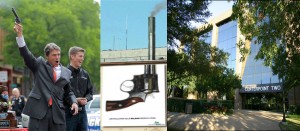 The latest chapter in a decades old mystery game of "Get a Clue" happens tomorrow morning, Monday, June 16th when representatives of the Sierra Club and Downwinders at Risk present their case against the current state anti-smog plan during the regional air planning meeting at the headquarters of the North Texas Council of Governments, 616 Six Flags Road in Arlington. Come find out who and/or what keeps the DFW area from ever meeting federal clean air standards year after year and what can be done about it. The meeting starts at 10 am. Citizen groups are expected to do their presentations in the 11 to 12 hour. Then we'll all have a debriefing lunch at the Subway's down the street hosted by State Representative Lon Burnam. Y'all come.
The latest chapter in a decades old mystery game of "Get a Clue" happens tomorrow morning, Monday, June 16th when representatives of the Sierra Club and Downwinders at Risk present their case against the current state anti-smog plan during the regional air planning meeting at the headquarters of the North Texas Council of Governments, 616 Six Flags Road in Arlington. Come find out who and/or what keeps the DFW area from ever meeting federal clean air standards year after year and what can be done about it. The meeting starts at 10 am. Citizen groups are expected to do their presentations in the 11 to 12 hour. Then we'll all have a debriefing lunch at the Subway's down the street hosted by State Representative Lon Burnam. Y'all come.
We Won a Small Victory – Now Come Take Advantage of It
 This is why citizen participation matters.
This is why citizen participation matters.
Last week, local officials were balking at reserving a slot at next Thursday's regional air planning meeting for a presentation by UNT researchers on how gas industry emissions from the Barnett Shale could be adding to DFW's chronic smog.
After reading about the UNT research in the Denton Record Chronicle, Downwinders at Risk and State Representative Lon Burnam specifically asked the local Council of Governments to include the UNT work on the agenda.
At first, we were told that there was already one technical presentation scheduled for the meeting and there wouldn't be any time for a second.
That struck us as strange, since in the past, every such meeting has always had more than one technical presentation.
When we pointed this out in an e-mail with links to past meeting agendas to prove the point, we quickly got a different response. Suddenly, there would be time for the UNT presentation.
That wasn't so hard was it? All it took was a little logical push back. But if we hadn't supplied it, Thursday would be looking a lot different.
Now, we're asking you to please come and help us push back a little more.
State environmental officials are on record as saying the air pollution from gas mining and production in the Barnett Shale is not adding to DFW's smog.
A lot of us think otherwise.
Come next Thursday, on the 17th, you can listen to the new UNT research on fracking air pollution and ask Texas Commission on Environmental Quality officials directly what makes them so sure that gas pollution isn't hurting local air quality.
Because the format of these regional clean air meetings are now so informal, anyone in the audience can ask questions of a presenter. That means you – if you show up.
It doesn't matter if you don't know the technical lingo. This is all about wind direction, weather, and things that pollute. There are no stupid questions.
The new anti-smog plan that the state is building needs all the public scrutiny it can get. It needs tough examination by people who care about clean air and the truth.
Next Thursday, you can help us put the state on the spot.
This is the first opportunity in 2014 to speak up and sound off about our decades-long smog problem. Don't let the TCEQ leave town without hearing from you.
We fought and won the right for you to listen to this research because we thought it was important. Won't you please come and take advantage of this victory?
We need a good showing to prove DFW residents are still mad about breathing dirty air.
NEXT THURSDAY, APRIL 17th
10 am to 12pm
North Central Texas Council of Government headquarters
616 Six Flags Drive
(After the meeting, State Representative Lon Burnam and Downwinders will be hosting a lunch time de-briefing, location to be decided, so stay tuned.)
Look, we know this is a small victory. But state officials don't want to talk about how gas industry pollution may be making our local smog worse, even though there's evidence that it is.
That's exactly why we think we need to keep bringing it up.
Winning the right to hear a new scientific presentation on the connection between gas pollution and smog may not seem like much of a win, but it is when the Powers-That-Be don't want you to hear it.
We know that small victories like this can lead to larger successes.
In the 1990's the same state agency that's now denying gas pollution has any impact on DFW smog was saying exactly the same thing about the Midlothian cement plants.
It took lots of push back from citizens who knew better before we got the state to admit it was wrong.
Now, Ellis County is in the DFW non-attainment area and the cement plants have controls on them they would otherwise never have.
We need the same effort in 2014 to show the state is as wrong about gas industry pollution as it was about the cement plants.
Right now, Downwinders is the only group committed to organizing citizens around clean air issues in DFW.
But we just lost a funding source that was critical to us and we need your help to keep the pressure on. This money paid for staff work in the field.It's very easy to give securely online here, or you can send checks to our P.O. Box at the bottom of the page.
We really need your help. Thank you.
Another Chapter of “Why Don’t We See This in Midlothian?”
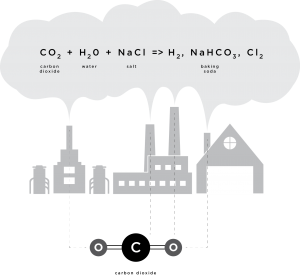 Cement plants are among the world's largest sources of CO2. In order to reduce their carbon footprints, either voluntarily or to comply with new environmental regulations, as well as make a buck, owners are trying out different strategies to turn their Greenhouse Gases into just plain green cash.
Cement plants are among the world's largest sources of CO2. In order to reduce their carbon footprints, either voluntarily or to comply with new environmental regulations, as well as make a buck, owners are trying out different strategies to turn their Greenhouse Gases into just plain green cash.
As far as we can tell, the "SkyMine" pilot-project announced for San Antonio's Capital Aggregates Cement Plant is still on schedule for operation later this year. Employing 50 people, the first-of-its-kind facility will convert the cement plant's carbon dioxide into baking soda and hydrochloric acid that's aimed at oil and gas field use.
Now comes word that a LaFarge Cement Plant in Canada is hooking up with a fuel cell company to make a slightly more progressive product from its GHGs:
"Mantra Energy Alternatives has struck a deal with Lafarge Canada to deploy an electrochemical reduction technology at Lafarge’s No. 9 Road cement plant.
“This will be the first pilot plant of its kind in the world,” said Mantra’s vice-president Patrick Dodd in a press release.
On paper, the technology would convert carbon dioxide, considered the most prolific greenhouse gas, into useful chemicals like formic acid and formate salts. The pilot plant would convert 100 kilograms per day of carbon dioxide emitted from the local cement plant into concentrated formate salts, which sell for about $1,500 per tonne.
Mantra is eying the formic acid for use in its patented fuel cells, which it bills as a significantly less expensive fuel cell with greater power density."
Granted, the manufacturing of oil and gas chemicals sounds more likely for one of the three huge Midlothian cement plants to attempt than diving into the alternative energy business, but at least it's something. The end products can change and adapt but these projects begin to put the infrastructure of a supply and demand system in place while seeing potentially large decreases in CO2 output. In 2014 America, the fastest way to get reductions in GHGs is to make it profitable to do so. These experiments pave the way for that to happen.
There's no question that the TX/ Martin-Marietta, Holcim and Ash Grove cement plants are the largest stationary sources of CO2 in North Texas, or that together, they form a huge GHG hotspot. All the old coal-fired power plants that would have challenged them have been shuddered or converted to gas.
While (forced) modernization at all three plants like the conversion from wet to dry kiln technology has brought all emission totals down, particularly CO2, the fact remains that the huge scale of operations in Midlothian means there's no other facilities that churn it out as much. And yet not one creative idea for how to reduce those huge local emissions has been announced from any of those companies. You can't just use the Texas excuse because the San Antonio experiment is happening despite no immediate government mandate, especially on existing facilities. And you might think that the first company to do so would receive some needed good PR. But nope.
This has been another chapter of "Why Don't We See This in Midlothian?"
